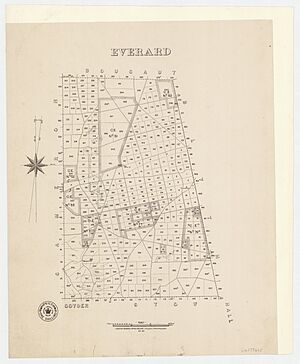Everard Central, South Australia facts for kids
Quick facts for kids Everard CentralSouth Australia |
|||||||||||||||
|---|---|---|---|---|---|---|---|---|---|---|---|---|---|---|---|
| Postcode(s) | 5461 | ||||||||||||||
| Location | 108 km (67 mi) N of Adelaide | ||||||||||||||
| LGA(s) | Wakefield Regional Council | ||||||||||||||
| Region | Mid North | ||||||||||||||
| State electorate(s) | Frome | ||||||||||||||
| Federal Division(s) | Grey | ||||||||||||||
|
|||||||||||||||
Everard Central is a small place in the Mid North region of South Australia. It's about 108 kilometers (67 miles) north of Adelaide, the state capital. This area is known for its flat plains and farming land.
Everard Central is located within a larger historical area called the Hundred of Everard. A "hundred" is an old way of dividing land for administrative purposes.
Contents
What is the Hundred of Everard?
| Everard South Australia |
|||||||||||||||
|---|---|---|---|---|---|---|---|---|---|---|---|---|---|---|---|
| Established | 24 May 1867 | ||||||||||||||
| Area | 215 km2 (83.0 sq mi) | ||||||||||||||
| County | Stanley | ||||||||||||||
|
|||||||||||||||
The Hundred of Everard is a specific land division in South Australia. It's part of the County of Stanley. This "hundred" was officially created on May 24, 1867.
Who was Everard named after?
The Hundred of Everard was named by Governor Dominick Daly. He chose the name to honor William Everard (1819–1889). William Everard was an important person in South Australian politics during his time.
What is the geology of Everard Central?
The land around Everard Central has some interesting natural features. You can find several dry lake basins here. These lakes only fill with water after heavy rain.
What are lunettes and gypsum?
Around the edges of these dry lake basins, there are special sand dunes called lunettes. These lunettes contain deposits of a mineral called gypsum. Gypsum is a soft mineral that is often used in agriculture to improve soil.
How is gypsum used?
Gypsum is mined in the Everard Central area for use in farming. For example, in 2002, about 35,000 tonnes of gypsum were collected by companies like G.J. Mills and McArdle. This shows that the area's natural resources are important for local agriculture.



